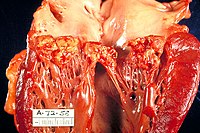
Photo from wikipedia
BACKGROUND Mitral valve infective endocarditis (IE) in children is rare, and there are few reports on the outcomes of surgery in these patients. This study investigated the long-term outcomes of… Click to show full abstract
BACKGROUND Mitral valve infective endocarditis (IE) in children is rare, and there are few reports on the outcomes of surgery in these patients. This study investigated the long-term outcomes of mitral valve repair in children with IE. METHODS Data were retrospectively obtained from medical records and correspondence. Univariable regression analyses were performed and outcomes including survival and freedom from reoperation were analysed using the Kaplan-Meier method. RESULTS Surgery for native mitral valve IE was performed in 39 patients between 1987 and 2020. Of these, 92.3% (36/39) of patients underwent mitral valve repair, while 7.7% (3/39) required replacement. Median age was 8 years. Preoperatively, 80.5% (29/36) of patients had moderate or greater mitral regurgitation. Congenital heart disease was present in 38.9% (14/36), while 11.1% (4/36) had rheumatic heart disease and 25.0% (9/36) had prior cardiac surgery. Postoperatively, only 1 patient (2.8%, 1/36) had moderate or greater residual mitral regurgitation. There were 2 early deaths (5.6%, 2/36), with survival being 94.1% (95%CI, 78.5-98.5) at 15-years. At 10-years, freedom from reoperation was 62.9% (95%CI, 41.0-78.5) while freedom from mitral valve replacement was 80.2% (95%CI, 55.5-92.3). Larger vegetation size was a risk factor for embolic events both pre- and postoperatively (OR 1.15, p=0.02). CONCLUSIONS Mitral valve repair is feasible in the majority of children requiring surgery for mitral valve IE. Survival is excellent, and at 10-years, approximately two-thirds of patients are free from mitral reoperation, and 80% are free from replacement. Larger vegetation size is associated with increased risk embolic events.
Journal Title: Seminars in thoracic and cardiovascular surgery
Year Published: 2022
Link to full text (if available)
Share on Social Media: Sign Up to like & get
recommendations!